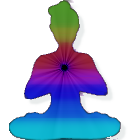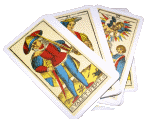
Haindl Tarot
FIVE OF WANDS - CONFLICT
NEW TITLE: "CREATIVE CONFLICT"
I CHING: 49, "REVOLUTION"
REVERSED I CHlNG: SO, TING, "THE CAULDRON"
As the original title implies, this is one of the more difficult cards in the suit of Wands. The idea of conflict actually belongs to Fire, because the aggressive energy seeks to test itself in battle. This can lead to positive results, when the people involved see the battle as a thrilling game. We speak of such things as "the conflict of ideas" or "creative struggle." Here the new title definitely gives us a more positive approach, one that is in keeping with the attitude to the card found in many modern decks. However, if one side seeks dominance at all costs - rather than the creative release of its own energy - then the conflict turns into something much harsher than a game.
The hexagram, 49, means "Revolution" in Wilhelm and "Changing" in Wing. In modern times we tend to look favorably on revolution. The French, the Americans, the Russians, the Chinese, and so on, all celebrate their own revolutions. When a new revolution happens, people outside treat the new group positively, at least until they do things the outside world dislikes. In other situations, such as science or the arts, revolution means "a dynamic change, bringing great improvements and opportunities."
The I Ching, however, values stability and harmony. It seeks smooth, gradual change rather than violent reversals. Therefore, hexagram 49 implies danger, chaos, extreme situations. In Chinese thought revolution should only happen when the situation has gotten so out of balance that no gentle approach will work. Part of the purpose of the I Ching is to prevent such dangers from arising by showing people how to act in harmony with the moment.
The reversed hexagram, 50, is the one that appears on the Three of Wands, whose theme is "Virtue," or "Centered Power."
It suggests the importance of focusing our energy in the midst of upheavals or dangerous situations.
The picture in the Five of Wands shows a detail from a Haindl painting named Oedipus. We see the top of a stone column - another lingam. The column appears to be changing shape, merging into the organic, like the stone tree in Kathedrale. This theme of transformation belongs with Fire, which changes things from one form to another, melting solids, turning liquids into gas. The top of the column resembles the brain in shape. This links the column with the spine so that the picture suggests the human body.
At the same time the column is dark and chaotic, symbolizing among other possibilities, the violence of history. The spears rise up from the dark below, as if striving to go away from the dark bloody past. But as we saw in the Devil and the Tower, we need to come to terms, not only with history, but with our own inner darkness. Conflict often comes from people projecting their own fears and anger outward onto enemies. This is the opposite of "creative argument:"
The spears do not rise equally, but with one higher than the others. This symbolizes hierarchy, which Hermann Haindl sees as a source of conflict and aggression, for the idea of one person or class considered superior to another leads to war and slavery.
The spears also symbolize the intellect's desire to leave the Earth, or to conquer nature as a means of escaping our origins as animals. Intellectual energy can represent the positive side of this card. For example, the decoding of DNA came partly through competition among scientists; with this knowledge doctors can seek better ways to treat genetic diseases. At the same time intellectual striving can lead to a break with reality, as when people see the making of terrible weapons as an interesting puzzle.
DIVINATORY MEANINGS
When the Five of Wands appears in readings right side up, we tend to look at its more positive aspects. It shows energy, excitement, people striving and battling but without hatred or bitterness. Creative argument. We can think of the person having thrown the spears, like a hunter seeking prey. The Five of Wands can be a card of someone active in the world. Still, we should not forget the dark chaos at the bottom. There may be areas of the person's life he or she wants to avoid or escape. The other cards will indicate whether this presents a problem.
REVERSED
The Five of Wands reversed emphasizes the more unhappy aspects. The conflicts become stronger, more personal and aggressive. Notice that when we reverse the card the spears come back at us, as if thrown by others. The reversed card sometimes indicates bitterness at other people's behavior.
KE - de omwenteling (het ruien)
HET OORDEEL
De Omwenteling.
Op de eigen dag vind je geloof.
Verheven welslagen, bevorderend door standvastigheid.
Het berouw verdwijnt.
HET BEELD
In het meer is vuur: het beeld van de Omwenteling.Zo ordent de edele de tijdrekening
En klaart hij de tijden.










